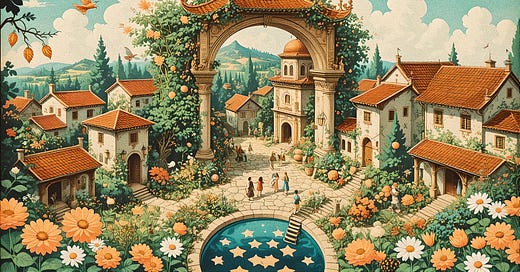Thread 011: The Birth of The Digital Flâneur
On wandering through virtual streets, finding inspiration in unexpected corners, and the art of curious exploration across dimensions...
The French poet Charles Baudelaire once described the flâneur as "a passionate spectator," one who finds home in the fleeting and the infinite, who thrives in the wavering heart of a crowd. These urban wanderers—artists, writers, philosophers—moved through nineteenth-century Paris with deliberate aimlessness, collecting impressions that would later become art. Walter Benjamin called it "botanizing on the asphalt," this practice of reading city streets like texts, of finding meaning in the seemingly mundane.
I've long cultivated this art in Toronto's physical landscape—tracing ravine systems that cut through neighbourhoods like secret passages, discovering doorways in The Annex that seem to belong to other centuries, watching morning light transform brick buildings into canvases of copper and gold. These wanderings have never been mere recreation but a form of research, a gathering of impressions that later weave themselves into brand worlds, creative frameworks, or simply a deeper understanding of how spaces shape human experience.
What I didn't expect was how naturally this practice would translate to digital realms.
In my role at Blaze, I find myself developing a new form of flânerie—one that unfolds not through physical streets but through the digital "neighbourhoods" of our growing community. Each day brings opportunities to witness unexpected moments of connection, to observe patterns of interaction, to collect stories that unfold in comment threads and video calls. I've become what you might call a digital flâneur, wandering with attentive curiosity through spaces built of code rather than concrete.
The parallels are more profound than I initially realized. Just as physical cities have their rhythms and flows—busy intersections at certain hours, quiet corners that come alive at dusk—digital communities develop their own temporal patterns. There's the Monday morning rush of entrepreneurs setting intentions for their week, the Wednesday afternoon lull when focus deepens, the Friday celebrations of weekly achievements. I find myself noting these patterns with the same attentiveness I might give to the changing light on Toronto's brick buildings throughout a day.
Last week, I observed a fascinating interaction that might serve as a perfect example of digital flânerie's rewards. A new community member posted a hesitant question about a feature they couldn't understand. Within minutes, three others responded—not with simple answers, but with stories of their own confusion, personal workarounds they'd developed, and encouragement that transformed an isolated moment of frustration into a collective experience of problem-solving. I watched this unfold not as a moderator looking to measure engagement, but as a witness to something fundamentally human happening in supposedly inhuman space.
What struck me was how this exchange mirrored interactions I've witnessed in physical third places—those coffee shops, bookstores, and public squares where community forms through casual, unplanned encounters. The rhythm of question, response, elaboration, gratitude followed patterns I've observed at neighbourhood cafés, where a question about the menu might evolve into exchange of local knowledge. The digital interface hadn't eliminated these patterns but translated them into new forms.
Rebecca Solnit writes in "Wanderlust" about how walking allows us to be "in the body and in the world without being made busy by them." Digital flânerie offers something similar—a way to be present in virtual space without being consumed by its demands, to observe without immediate purpose, to gather impressions that might later crystallize into insight.
I find myself developing rituals for this practice. Each morning, I spend twenty minutes simply moving through our community spaces without posting or responding—just observing, collecting, witnessing. I note which topics generate unexpected connections. I watch how certain members naturally adopt roles as welcomers, others as knowledge-sharers, still others as celebrators of milestones. I pay attention to the language people use when they feel safe enough to be vulnerable about their challenges.
This isn't analysis for metrics or optimization—it's something closer to what Jorge Luis Borges might have done had he been transported to our digital age. His fascination with labyrinths and infinite libraries feels remarkably resonant with digital space, where paths connect in unexpected ways, where seemingly separate conversations reveal themselves as threads in the same expansive tapestry.
There's a Japanese concept called "ma" (間) that refers to the space between things—the pause in conversation, the interval between notes in music, the negative space in visual composition. Digital environments, despite their seeming density of content, are equally defined by these spaces—the moments between interactions, the gaps where meaning forms, the silences that give shape to connection. My wanderings have made me increasingly attentive to this digital "ma," to what happens in the spaces between posts, comments, and reactions.
What's most fascinating is how this practice bridges my current work and future vision. The attentiveness I'm developing as a digital flâneur is precisely what will serve me in building a life between Barcelona's Gothic Quarter, Mallorca's ancient landscapes, and Toronto's familiar streets. All require the same fundamental skill: the ability to notice patterns, to gather stories, to find meaning in both presence and absence.
I think of how Italo Calvino, in "Invisible Cities," describes Venice not as a single place but as countless cities layered upon each other—each version visible to different observers, during different hours, through different qualities of attention. Our digital spaces contain this same multiplicity—they are simultaneously business ecosystems, creative communities, learning environments, emotional support networks, each layer visible depending on how we choose to observe.
Barcelona's modernist architect Antoni Gaudí was known for his extraordinary observational skills—studying natural forms for hours to understand the structural principles he would later incorporate into his revolutionary designs. His process wasn't just creative but deeply attentive, founded on the belief that careful observation of one realm could inform creation in another. This cross-pollination between observation and creation, between natural and constructed environments, between organic patterns and designed spaces—this is precisely what digital flânerie makes possible.
The community spaces I'm helping build at Blaze are becoming, in their way, architectural projects—designed environments that shape human experience, that encourage certain paths while allowing for unexpected diversions, that create both grand boulevards for collective celebration and intimate corners for meaningful exchange. The insights I gather through daily wanderings inform how we adjust these spaces, just as a physical architect might refine a building's design after observing how people naturally move through its initial structure.
There's something wonderfully recursive about this process. My physical flânerie through Toronto informs how I understand digital wandering, which in turn shapes how I approach community architecture, which will ultimately influence how I create a life between physical cities. Each domain of experience becomes a mirror for the others, each practice deepening my ability to notice what matters across contexts.
Walter Benjamin believed that the flâneur's seemingly aimless wandering was actually a revolutionary act in a world increasingly defined by purposeful efficiency. Perhaps digital flânerie serves a similar function today—a deliberate reclaiming of attentive presence in spaces often designed for rapid consumption and measurable interaction. To move slowly, curiously, and without immediate purpose through digital environments is to resist the frantic pace of our technological moment, to assert that meaningful observation requires a different quality of time.
As my golden thread continues to weave between present work and future dreams, between digital architecture and physical cities, I find comfort in knowing that this practice of attentive wandering translates across all domains. The flâneur is never lost, merely gathering—collecting impressions, stories, patterns that will later reveal themselves as essential threads in the tapestry of understanding.
Whether wandering Barcelona's winding streets, Mallorca's coastal paths, Toronto's urban grid, or the intangible neighbourhoods of digital community, the practice remains the same: to move with curious attention, to witness without judgment, to collect moments not as tourist but as participant-observer in the ongoing story of how humans create meaning together across every kind of space.
Tracing the golden thread,
P.S. Perhaps the most profound revelation of the flâneur—digital or physical—is that we never truly wander alone. Our observations become part of a collective witnessing, our gathered moments contributing to an unwritten archive of human experience. I wonder what silent conversations might be happening between your gathered impressions and mine, what invisible patterns might be forming in the spaces where your wanderings and my own briefly intersect on this page. In what seemingly ordinary corner of your world—physical or digital—is an extraordinary pattern waiting to be recognized only by your particular quality of attention?






